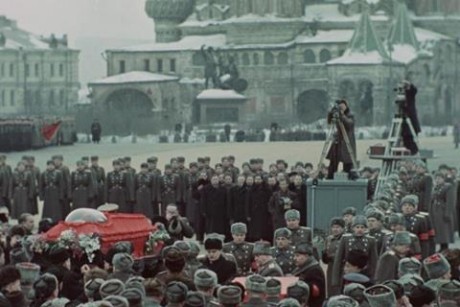


Sergei Loznitsa: State Funeral

March 1953. Joseph Vissarionovich Stalin dies. The great leader is to be mourned all over the Soviet Union. For five full days. Cameramen are sent to all republics to catch the well orchestrated mise-en-scène of the State Funeral. Loads of film material is shot, since then some of it has been shown in official films, most of it was archived. And of course not only visuals but also radio broadcasts transmitting officlal homages to the Genius, the Immortal, the one who will, even if he has died, lead the communist workers all over the world to victory in the spirit of Lenin and Stalin. Speeches, poems, music…
Sergei Loznitsa and his editor, Lithuanian Danielius Kokanauskis, have been in the archives to invite the viewer into a fascinating grandiose visual tour that has a beginning and an end: The announcement of the death on radio and through loudspeakers, the coffin that goes so everyone can pay respect by defiling past the dead leader – till the coffin goes into the mausoleum on the Red Square. Masses of people everywhere, in cities, in villages, at the sea on the ships.
In an interview at the NY Lincoln Centre Loznitsa (find it on Youtube) explains that having decided upon this simple chronological structure, it was his job to decide, what should be between start and end. The decisions were probably difficult but what comes out is fascinating because of the method of repitition the director and his editor has chosen:
People in the streets queuing to buy newspapers, all these different newspapers with the same photo and the same text… not only a couple of buyers but Soviet citizens one after the other buying their paper. Face after face, many with tears in their eyes, and from them
The film is in colour and black&white. Did you colourize, he was asked at the screening in New York. No, when we got the positive film material it was in black&white but when we went to the negatives. we found out that a lot was in colours. So I was not the one, the laughing director said. The same with music, a lot was already there in the radio broadcasts. But of course we did a lot of sound in the studio. The steps in the streets and on the stairs, the crying, the coughing etc.
It’s amazing to watch a winter dressed nation defiling, queuing, carrying the flowers – and it is amazing to watch the elegant editing, where you have faces turning in one direction in sequence after sequence, and then a change of turn to the other direction, constant movements, masses after masses, with accompanying words and music. What a sense of rythm!
Sometimes, however, it becomes a bit comic, of course, especially at the veery loong sequences of the communist leaders arriving in their propeller aircrafts, going down the stairs, getting a handshake welcome and then into black cars, one after the other. Including people like Ulbricht and Ceaușescu and Chou en Lai.
Not to forget – towards the end of the film and at the beginning of a new (post-stalinist) era – where – the location is well known – the mourning speeches on the Red Square with Nikita Khrushchev as the one presenting the people he soon after would get rid off to take over the power, first Malenkov who would succeed Stalin as first secretary of the Central Committee of the Communist Party, and later the powerful beast Lavrentiy Beria.
So what do you take from this visual documentation of 5 days of mourning, a state funeral interpreted by a director, whose fascination of people in love with their leaders, in deep sorrow it is clear to see, with the entourage of the military people, the politicians taking everything much more cool, waiting for their turn, we think as viewers –
because we look at this film with the knowledge that Joseph Vissarionovich Stalin is one of the worst murderers in world history (a text at the end of the film says it: 7 million were murdered and 15 million starved to death).
So what do you take: Well, apart from the obvious overall theme of manipulation of the masses and the demonstration of an extraordinary skill to worship a leader beyond any doubt and reason, knowing that opponents were not filmed, I find it a gift to see the faces of the military, the faces of civilians, them often looking in the direction of the camera but turning their heads because of the ceremonial circumstances, the constant taking off hats in respect, the women with their head scarfs, the beautiful sceneries – at the sea, is it the Black Sea? – Loznitsa and his crew have cleaned the archive material to an almost perfect look; as he said in New York, some of it is so good that it could have been shot yesterday. It is very fine that the end credits name all the cinematographers, whose material has been used in the film.
They made Cinema, yes propaganda it was, but they knew the skills of filmmaking and Loznitsa knows how to put another original and also scary perspective to history, at the same time as it is a tribute to filmmaking. He did it again after ”The Event” and ”The Trails”. What’s next?
Netherlands, Lithuania, 2019, 135 mins.